Powder Coating is one of the most popular means of finishing parts. It creates a myriad of colors and various finishes, from glossy to matte, offering several advantages over conventional paint. Items coated with powder have many applications from domestic to industrial.
Powder is also cheaper, lasts longer, and is environmentally friendly, making it one of the best ways of finishing any metal part.
What is Powder Coating?
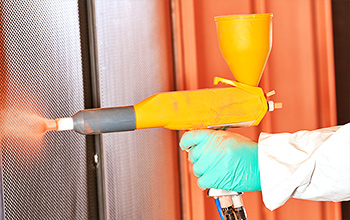 The straightforward answer is powder coating is a dry finish process. The process became popular in the US back in the '60s when introduced.
The straightforward answer is powder coating is a dry finish process. The process became popular in the US back in the '60s when introduced.
Powder gives finished metal products improved durability and high-quality appearance, reduces the environmental impact, and reduces costs. The Institute of Powder Coating lists several advantages of powder coating over other metal coatings such as copper, stainless steel, copper oxide, aluminum, nickel, zinc, or copper.
By perfecting the coating process, metal processors maximize production time while increasing functional and protective product properties and enhancing the decorative appearance. To appreciate the advantages of powder, one must first understand how they work.
Many businesses prefer powder because it offers a durable, high-quality, and simplified finish that's environmentally friendly and cheap. Powder coating is functional and protective, with colors available in many shades, textures, and finishes. Advances in technology have made sure that the finishes have become more durable and consequently last longer.
Development
Introduced in the 1950s, powder coating is the youngest commonly used finishing process used and the fastest growing. Early applications required fluidized-bed applications with a typical thickness between 150 and 500 μm. The first uses of powder were functional rather than aesthetic.
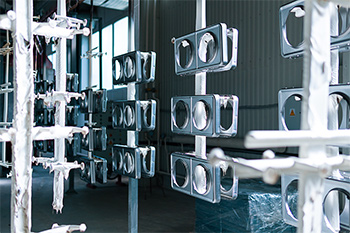 Introducing electrostatic spraying opened the door for powder coating to become a commercially economical solution. Not only did this unfamiliar application process continue the practical use, but it also added decorative features. Spraying powder allows for thinner amounts of powder. It also increases the variety of components for coating, especially parts not previously coated through the wet application process.
Introducing electrostatic spraying opened the door for powder coating to become a commercially economical solution. Not only did this unfamiliar application process continue the practical use, but it also added decorative features. Spraying powder allows for thinner amounts of powder. It also increases the variety of components for coating, especially parts not previously coated through the wet application process.
Powder manufacturers developed epoxy, epoxy-polyester hybrids, polyurethane, and polyester resins in the 1960s and 1970s. This new technology became popular over traditional coating applications because of pollution and health concerns from organic solvents.
Commercial powder coating hit its sweet spot in the 1980s from improving color range, application efficiency, and textures. Powder coating, today, represents about 9% of all industrial coatings in the finishing industry.
Where Used?
All markets take advantage of the powder coating process. However, technology constraints and competition with wet coatings limit universal usage. Industrial segments using powder coat include:
- Automotive
- Appliances
- Architecture Metal
- Metal Furniture
- Computer Cases
To be coated, meeting three criteria is necessary before processing components:
- The substrate must be suitable in design and size
- The object to be coated must be suitable for both design and size.
- The substrate must be conductive or made temporarily conductive.
Metallic objects have proved to be suitable. However, modern materials, such as plastics and timber derivatives (MDF), can also be powder-coated.
How Does the Process Work?
Companies providing a powder coat finish using polymer resin, combining pigments, curatives, flow modifiers, leveling agents, and other additives. All ingredients are initially melted-mixed, cooled, and ground into a fine powder-like flour.
A free-floating dry powder receives a positive electric charge sprayed under pressure on an unfinished or fabricated metal object grounded with a negative charge. Water is a deadly enemy for powder coatings, mainly when applied in the electrostatic spray process.
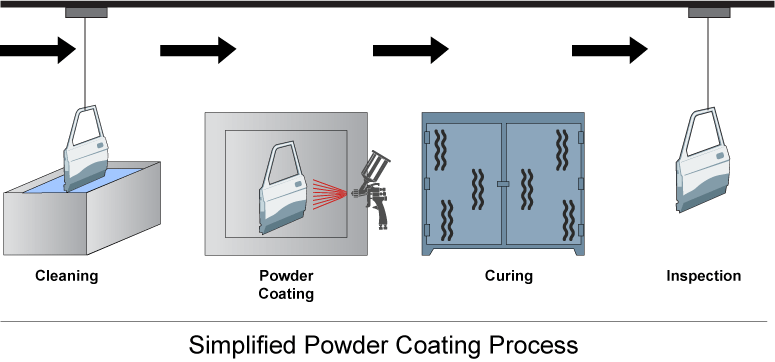
This results in an electrochemical change in which it coats the metal with long molecular chains from the powder. Once the powders have reached temperature, they merge and form long chemical chains that give the coating its stiffness and durability.
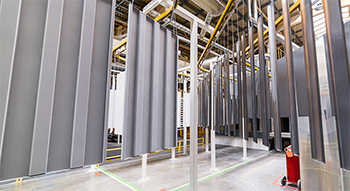 Once the finish's surface has reached room temperature, it takes on a gel-like consistency - until fully cured, most powder coatings melt before curing.
Once the finish's surface has reached room temperature, it takes on a gel-like consistency - until fully cured, most powder coatings melt before curing.
Advanced metal coatings extend the service life of components and can also prevent corrosion. Stainless steel parts treated with powder coating withstand wear and tear from weather and other influences. It is ideal for a working environment, such as a factory or factory floor, as an advanced metal coating that prolongs and prevents corrosion and prolongs the components' life. This ensures that a superior powder coating protects the surface of the stainless-steel piece.
Powder Coating Benefits
Powder coating leads to several advantages over other paint applications; the most common include:
Cost-Effectiveness
Purchasing the exact amount of powder needed for a project eliminates the need of storing leftover powder. Alone, the powder is less expensive than wet paint. Uncontaminated and undamaged powder over-spray is recyclable: reused after reclaiming it for future applications.
Also, eliminating extra steps and extra drying time round out the many examples of cost-effective powder coating.
Durability
Powder coating is an economical, long-lasting, and durable finish. Surfaces protected with powder coating are resistant to chipping, fading, scratches, and wear. The colors remain durable and last longer. Using textures, explained below, increases protection.
The finish produced by powder coating is durable, long-lasting, decorative, and protective. Powder coating shows higher resistance to moisture, chemicals, impacts, and harsh weather. Coatings last through thousands of hours of salt spray testing. They also act as electrical insulators.
Efficient Process
Using an electromagnetic charge ensures the powder sticks to the part, reducing waste. The spray nozzle uses only the amount of powder needed. They reclaim the excess powder for future projects.
Curing and Drying
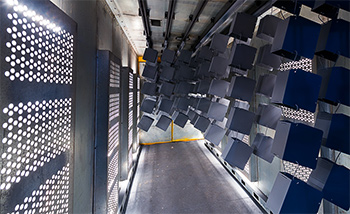 Compared to wet coatings, the powder needs a less amount of curing, processing, and drying times. Liquid paint needs time drying at room temperatures first, then needs time in curing ovens. Only after cured can wet paint components become assembled.
Compared to wet coatings, the powder needs a less amount of curing, processing, and drying times. Liquid paint needs time drying at room temperatures first, then needs time in curing ovens. Only after cured can wet paint components become assembled.
The vast time differentials are significant compared to powder coating. Curing takes minutes, assembly and packaging occur immediately.
There are safety considerations, too. Wet paint applications need more air and air changes filtering out any VOCs. Powder coating applications need less air and air exchanges. Both methods require outside venting, but since powder doesn't contain VOCs or solvents, the heated air is recycled, filtered, and emptied back into the shop.
Variety
Applying powder coating to many nonmetal and metal materials creates opportunities for including varying ranges of colors, finishes, thicknesses, and textures.
Coating thickness is a significant advantage over wet paint applications. Liquid coatings may sag, run, or dip while containing a slight amount of solid material. This smaller number of solids requires more applications, while powder needs fewer passes. The turnaround time for applying the powder coat is substantially less than that of wet applications requiring less coating and quicker curing and drying times.
The number of colors formulated for powder coating is nearly limitless. Adding the color to several mechanical, decorative, and physical characteristics result in exponential combinations. Adding a textured layer hides blemishes on the surface, such as depressions, scratches, dimples, and recesses, It reduces the need for additional steps in the finishing process.
Maintenance
Long-term maintenance becomes easier with powder coating. Using soapy water rinsed with water avoids using any special solvents or cleaners. With its resistance to corrosion, dealing with damage or rust becomes simple.
Environmentally Friendly
The makeup of the powder contains no solvents or harmful chemicals, making it safe for disposal. There are no VOCs released, and waste is minimal during spraying.
Other advantages of using powder coating include:
- Lower carbon dioxide emissions
- No hazardous waste disposal
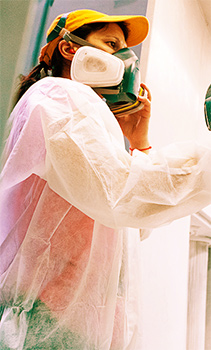 Powder coating requires no primer before coating—especially advantageous for aluminum applications. Aluminum usually contains chrome, which has carcinogenic properties and is toxic.
Powder coating requires no primer before coating—especially advantageous for aluminum applications. Aluminum usually contains chrome, which has carcinogenic properties and is toxic.
Although environmentally safe, people applying powder coat need to wear protective clothing.
Quality
The finish is always excellent. No unevenness, dripping, running, or other issues associated with wet paint.
Powder Coating Disadvantages
There are two sides to everything. Here are disadvantages to powder coating, too.
Material Suitability
It limits the number of substrates available to powder coating: powder coating requires curing. The substrate must withstand curing temperatures without deformation.
Grounding nonmetal substrates for electrostatic spraying isn't possible as with metal objects. Instead, they require a fluidized bed powder coating process, opening the door to an inconsistent and uneven coating. Fluidizing beds add to operating costs on top of establishing a fully capable powder coating facility.
Coating Thickness
Powder coating easily achieves thick and smooth surfaces, while thin layers are more complicated. Controlling speed and the number of powder limits the amount of material deposited. Unlike thicker coatings, thin coatings, less than 6 mils, can't hide surface imperfections.
For thin coating applications, wet coatings are easier to manage than powder.
Line Changes
Switching color in powder lines is time-consuming. Reclaiming unused powder requires meticulous emptying between each color change. Any leftover material results in cross-contamination of powder resulting in the quality of the parts and finish.
Significant Part Drying and Curing Times
A majority of powder coating applications need less curing, processing, and drying times. For larger, heavier, and thicker parts need more extended curing and drying times comparatively. These additional times increases energy costs. More significant parts require sufficient heat, dispersed throughout the material. Reaching the correct temperatures needs increased amounts of heated air and exhaust, which also increases the time necessary to finish the process.
Greater start-up costs
Powder coating becomes cost-effective because of the coating durability, quick application, and curing times. However, initial costs for starting a powder coating line add up quickly. A proper powder coating application process needs a spray booth, spray guns, and a curing oven. The cost and size of the curing oven limit the size and quality of the finished product. Expansion for more significant parts requires larger and stronger ovens, adding even more capital expense.
In Sum
Powder coating reinforces metal because it protects against corrosion, wear, and tear from weather and other influences.
Over the past decade, there has been an exponential increase in using powder coating. It's expected the global powder coating industry will reach a whopping $16.55 billion by 2024. One reason for this is the increasing use of non-traditional applications such as powder coating for door frames, windows, kitchens, buildings, and electrical fixtures.
The rise in construction spending in many countries will also contribute to this growth. Plus, government support for the eco-friendly and economical process helps further stimulate demand.